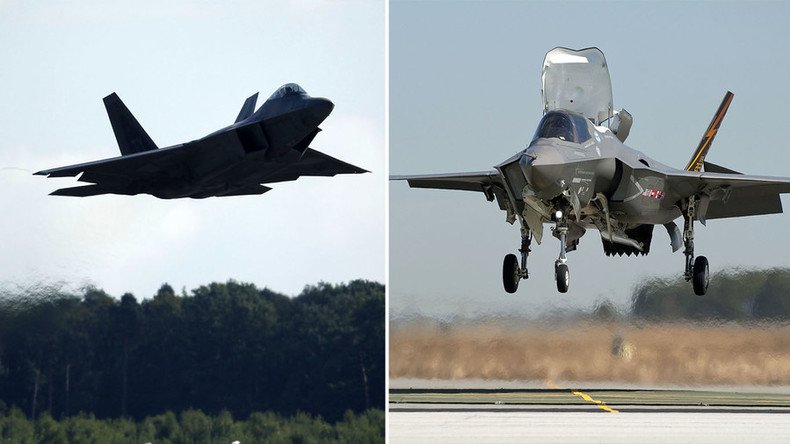Shooting down US ‘stealth’ jets not that hard, expert warns

The Pentagon's pricey fifth-generation jets are a lot easier to shoot down than previously believed, warns a US defense expert. Relatively simple modifications to existing radar and missile technology could sweep the F-22s and F-35s right out of the sky.
Defense and industry officials alike have shrugged off reports that the F-35 Joint Strike Fighter can’t hold its own in dogfights against older-generation airplanes, figuring that the jet ‒ whose lifetime cost is now estimated at $1.5 trillion and counting ‒ may be stealthy enough to avoid ever getting into a proper scrap. That may not be the case for very long, according to Dave Majumdar, defense editor at National Interest magazine.
“Relatively simple signal processing enhancements, combined with a missile with a large warhead and its own terminal guidance system, could potentially allow low-frequency radars and such weapons systems to target and fire on the latest generation US aircraft,” Majumdar wrote this week.
The secret to "killing" an F-35 strike fighter: https://t.co/I7XTqAxq2Zpic.twitter.com/JiyTs00oI9
— National Interest (@TheNatlInterest) February 25, 2016
While the Pentagon and US weapons industry have known for a long time that low-frequency radars operating in the VHF and UHF bands can detect and track stealth aircraft, the conventional wisdom has been that such radar could not generate a “weapons quality” track capable of guiding air defense missiles to their targets.
Majumdar summed up this thinking by quoting a rhetorical question from an unnamed US Navy officer in one of his earlier articles, who asked, “Does the mission require a cloaking device or is it OK if the threat sees it but can’t do anything about it?”
According to at least one electronics warfare officer of the US Air Force, there are ways of getting around the guidance problem. The two main challenges to using low-frequency radars to guide weapons – the width of the radar beam and the length of the pulse – can be solved using signal processing, retired USAF Colonel Mike Pietrucha told Majumdar.
The pulse can be compressed using frequency modulation, Pietrucha said, noting the technology to do this has been around since the 1980s. Using phased radar arrays with electronically controlled beams solves the problem of directional or azimuth resolution. This is the engineering behind the US Navy’s Aegis system, which is found on the Ticonderoga-class cruisers and Arleigh Burke-class destroyers.
With the aid of such a ground or ship based guidance system, even an “antiquated” missile such as the S-75 “Dvina” (SA-2 in NATO parlance) could be used to blast stealthy jets right out of the sky. A missile equipped with its own guidance system – for example, an infrared sensor – would be even more dangerous to the fifth-generation US jets, wrote Majumdar.
US stealth fighters have already run afoul of 1960s-era air defenses. In March 1999, during the NATO campaign against Yugoslavia, one air defense battery in central Serbia shot down an F-117 Nighthawk stealth fighter with S-125 “Neva” missiles. The Nighthawk, which was praised as a revolutionary weapon system after the 1991 Gulf War, was retired from service in 2008. Pieces of its wreckage are still on display at the Belgrade Aviation Museum.
Unlike the F-117’s angled design, both the F-22 and the F-35 have sleek lines intended to make radar detection harder while keeping the aircraft relatively maneuverable.
The F-22 Raptor was envisioned as the Air Force’s replacement for the F-15 and F-16 jets, primarily as an air superiority fighter that also has ground attack capability. Fewer than 200 were produced – at a cost of $66 billion – before the program was scrapped in 2011 in favor of the upcoming Joint Strike Fighter.
However, the F-35 JSF has turned out to be an even bigger boondoggle. Costs have exceeded $1.5 trillion for a plane that can’t win a dogfight against older-generation jets, while tests keep revealing problems faster than the engineers can address them.
Still terrible: Pentagon releases new list of F-35 program issues https://t.co/zFTthbZnDupic.twitter.com/bdW16ngx0L
— RT America (@RT_America) February 4, 2016













